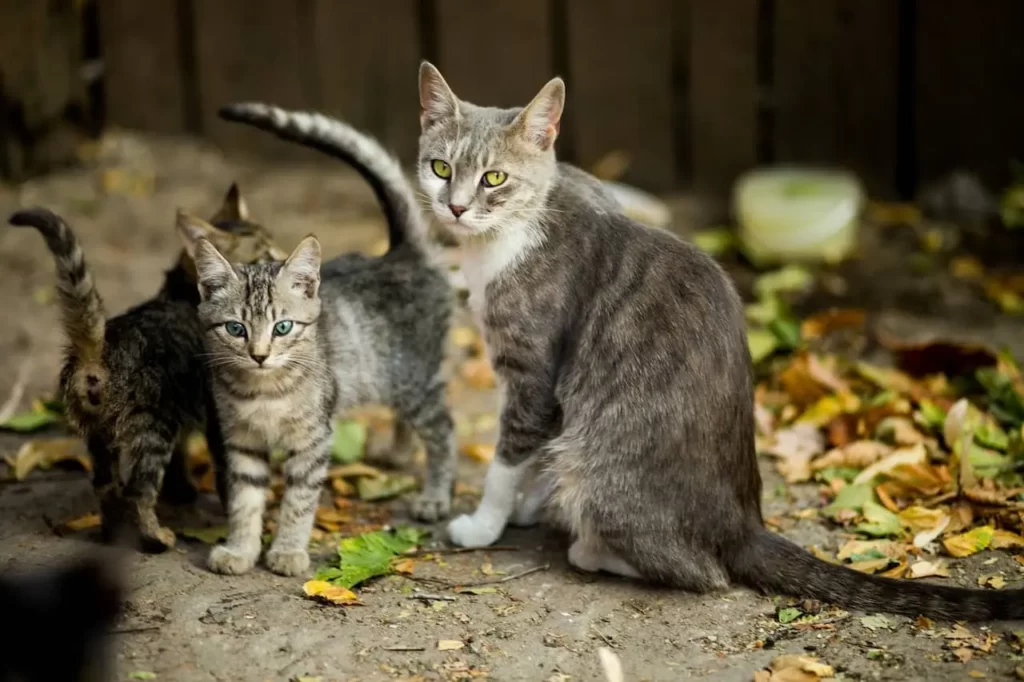Cats have long captivated us with their adorable and playful nature, and nothing quite melts our hearts like a litter of tiny, furry kittens. But have you ever wondered how many kittens a cat can have? It’s a fascinating question that often sparks curiosity among cat lovers and enthusiasts.
In this blog post, we’ll explore the factors that influence litter size, explore average litter sizes, discuss breed differences, and highlight the importance of responsible pet ownership.

How Many Kittens Can a Cat Have?
How Many Kittens Can a Cat Have? A domestic cat can give birth to 4 or 6 kittens. However, litters can be as small as one kitten or as large as 12 or more.
The exact number of kittens in a litter can vary based on factors such as the cat’s breed, health, and age.
Read Also: How Long Can a Cat Go Without Urinating?
5 Factors Affecting Cat Litter Size
The number of kittens a cat has in a litter can be influenced by several factors. Here are some key determinants:
1. Breed: How does cat breed affect litter size?
Different cat breeds exhibit variations in litter size. For instance, breeds like the Siamese and Abyssinian tend to have smaller litters, while breeds like the Maine Coon and Ragdoll may have larger litters.
These breed differences can be attributed to genetic factors and the natural selection that shaped each breed’s characteristics over time.
2. Age and Health
Younger cats and older cats generally have a smaller litter. Cats that are in their prime reproductive age, typically between 2 to 6 years old, tend to have larger litters.
Additionally, the overall health and reproductive health of the cat can impact litter size.
Read Also: Why does my cat hate me but love everyone else
3. Genetics
The genetics of the cat play a role in determining litter size. If the cat’s parents had large litters, there is a higher chance that the cat will also have larger litters. However, genetics alone cannot predict the exact number of kittens in a specific litter.
4. Environmental Factors
Environmental factors, such as the cat’s nutrition and stress levels, can influence litter size. A well-nourished and stress-free cat is more likely to have a healthy and larger litter compared to a cat with poor nutrition or high levels of stress.
5. Chance
Despite these factors, the number of kittens in a litter can still be somewhat unpredictable. Even within the same breed and under similar conditions, there can be variations in litter sizes.
Factors such as the number of eggs released during ovulation and the successful fertilization of those eggs also contribute to the final litter size.
It’s important to note that while larger litters are possible, it’s essential to consider the health and well-being of the mother cat and the ability to care for all the kittens.

Can We Increase the Cat’s Litter Size?
No, it is not possible to directly increase the litter size of a cat. The number of kittens a cat has in a litter is primarily determined by factors such as genetics, breed, age, health, and environmental conditions.
These factors are beyond our control and cannot be manipulated to deliberately increase litter size.
It’s important to prioritize the health and well-being of the mother cat and the kittens rather than focusing on increasing litter size.
Cats have evolved to produce litters that are appropriate for their breed and individual circumstances. Breeding practices should be responsible and considerate of the health and welfare of the cats involved.
Read Also: How much hair does a cat shed in a day?
Cats First Litter? What to Expect
When a cat has her first litter of kittens, there are several things you can expect. Here are some key points to consider:
1. Pregnancy duration: The gestation period for cats is typically around 63-65 days, but it can vary slightly.
2. Nesting behavior: As the delivery date approaches, the pregnant cat may start looking for a quiet and comfortable place to give birth. Provide her with a secluded area, like a birthing box, lined with soft blankets or towels.
3. Labor and delivery: The cat will go into labor when it’s time to give birth. Signs of labor include restlessness, increased vocalization, nesting behavior, and contractions. The delivery process usually lasts between 2 to 6 hours. During this time, the cat may become more vocal and exhibit signs of discomfort.
4. Size of the litter: First-time cat mothers typically have smaller litters compared to experienced ones. The average size can range from one to four kittens, but there can be variations.
5. Maternal instincts: Most cats instinctively know how to care for their kittens. They will lick the kittens to clean them, stimulate their breathing, and help them nurse. Ensure that the mother has a calm environment, and provide her with a balanced diet and fresh water.
6. Weaning: After a few weeks, the kittens will start to transition to solid food. The mother cat will teach them by example, but you can also introduce them to a high-quality kitten food softened with water.
7. Veterinary care: It’s essential to have a veterinarian check the mother and her kittens within a few days after birth. The vet can ensure everyone is healthy, provide necessary vaccinations, and offer guidance on caring for the kittens.
Remember that every cat and litter is unique, so there might be variations in behavior and development. If you have any concerns or questions, consulting with a veterinarian experienced in feline care is always recommended.
Read Also: Why do cats make biscuits

First Litter vs. Subsequent Litters
When a cat has her first litter, it is typically smaller in size compared to subsequent litter. The first litter may consist of two to three kittens, while subsequent litters tend to be larger.
This increase in litter size over time is due to the cat’s reproductive system maturing and becoming more efficient at producing offspring.
Multiple Pregnancies in a Cat’s Reproductive Life
Cats are capable of becoming pregnant multiple times throughout their reproductive lives. They are known for their ability to have several litters each year if they are not spayed.
This potential for multiple pregnancies underscores the importance of responsible pet ownership and the necessity of controlling the cat population.
The Importance of Spaying and Neutering
Spaying and neutering are essential procedures that help prevent unplanned litters and contribute to controlling the population of stray and feral cats.
By spaying or neutering your cat, you not only prevent unwanted pregnancies but also provide health benefits to your furry friend.
Read Also: Why Does My Cat Keep Sniffing Me?
Frequently Asked Questions
Can you tell how many kittens a cat will have by their nipples?
No! Examining a cat’s nipples alone cannot reliably determine the exact number of kittens she will have in a litter. While it is true that a cat’s nipples can become enlarged and pinker during pregnancy, this change is not directly proportional to the number of kittens she is carrying.
The size and appearance of a cat’s nipples can vary based on factors such as the stage of pregnancy, individual variation, and the cat’s overall health. It is not a definitive indicator of litter size.
How many kittens can a Persian cat have?
Persian cats can have varying litter sizes, but the average range is typically between 1 to 4 kittens per litter. However, it’s important to note that individual cats may have litters that fall outside of this average range.
Some Persian cats may have smaller litters, while others may have larger litters of up to 6 or more kittens. The exact number of kittens in a Persian cat’s litter can be influenced by factors such as genetics, age, health, and environmental conditions.
How many times can a cat get pregnant?
Cats are capable of becoming pregnant multiple times throughout their reproductive lives. They are known as polyestrous animals, which means they experience multiple estrus (heat) cycles during their breeding season, which is typically from spring to fall.
Generally, a cat can get pregnant as soon as she reaches sexual maturity, which is typically around 5 to 9 months of age. After giving birth, a cat can go into heat again within a few weeks, although it is recommended to allow her body to recover before considering another pregnancy.
It is important to note that allowing a cat to have multiple litters in quick succession without adequate time for recovery can have negative effects on her health and well-being. It is generally advised to practice responsible breeding and provide the cat with sufficient rest and care between pregnancies.
To prevent unwanted pregnancies and potential health risks, spaying (removal of the reproductive organs) or neutering (removal of the testes) is commonly recommended for cats that are not intended for breeding. Spaying or neutering your cat also helps control the cat population and can have various health benefits for the cat.
How many kittens can a small cat have?
The number of kittens a small cat can have in a litter can vary, but the average range is typically between 1 to 5 kittens.
Small cat breeds, such as the Singapura or Devon Rex, tend to have smaller litters compared to larger cat breeds. However, it’s important to note that individual cats may have litters that fall outside of this average range.
It’s worth mentioning that the size of the cat does not necessarily determine the litter size. Other factors, such as the breed, individual variation, and reproductive health, play a more significant role.
Conclusion
Understanding the potential litter size of a cat adds to our appreciation of these remarkable creatures. While the average litter size falls between one to nine kittens, various factors such as breed, age, health, and genetics can influence the number of kittens a cat can have.
Responsible pet ownership, including spaying and neutering, is crucial to ensure the well-being of cats and to help manage the cat population. So, the next time you encounter a litter of adorable kittens, you’ll have a deeper understanding of the factors that contribute to their numbers and the importance of being a responsible cat guardian.


